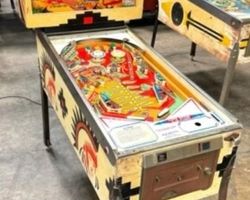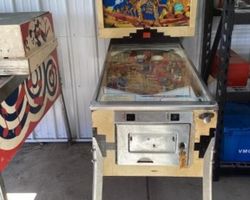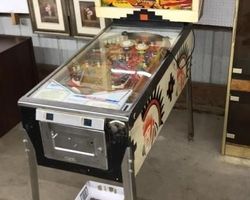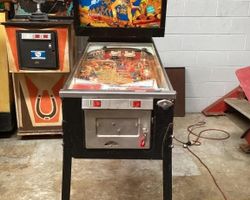Big Brave
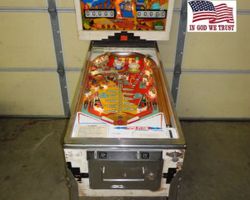
Average Prices: USD $300 to $1,100
Produced: May, 1974
Production Run: 3,450 units
Machine Type: Electro-mechanical
Players: 2
Design by: Ed Krynski
Art by: Gordon Morison
Gottlieb's "Big Brave," released in June 1974, stands as a notable electro-mechanical (EM) pinball machine from a prolific era of arcade innovation. Manufactured by D. Gottlieb & Co., a company long synonymous with quality pinball production, "Big Brave" emerged during a period when EM games were reaching their zenith before the widespread transition to solid-state technology. The machine’s creation was spearheaded by designer Ed Krynski, a name frequently associated with many of Gottlieb's most engaging titles, working in conjunction with artist Gordon Morison, whose distinct style imbued "Big Brave" with its visual character.
The theme of "Big Brave" draws from the American West, specifically depicting Native American adventure, a common motif in media of the time. This thematic choice was evident from its conceptual stage, with the machine originally bearing the trade show title "Big Injun." However, recognizing evolving sensitivities, Gottlieb made the decision to rename the two-player version to "Big Brave" before its official release. A four-player counterpart, sharing the same fundamental playfield design, was simultaneously released under the name "Big Indian." This careful renaming highlights a moment of adaptation within the industry, ensuring the game's theme resonated broadly. With a production run of 3,450 units, as confirmed by Gottlieb documentation, "Big Brave" was a significant release, priced at $855 FOB Chicago for operators, reflecting its position as a new entry in the competitive coin-op market. Its model number was 357, a detail that helps identify it within Gottlieb's extensive catalog.
Playfield and Core Mechanics
"Big Brave" showcases an engaging playfield design, balancing a classic EM feel with strategic depth. The layout centers around two flippers at the bottom, providing the primary means of ball control and shot execution. Above the flippers are two slingshots, positioned to react dynamically to ball collisions, contributing to unpredictable but exciting ricochets. The upper playfield is populated with key scoring elements. Two pop bumpers activate upon ball contact, sending the ball spiraling into new directions, often into advantageous positions for additional scoring. Three star rollovers are strategically placed to award points and potentially advance game features.
A defining element of the "Big Brave" playfield is the inclusion of two standup targets. However, the true stars of the interactive features are the vari-target and a bank of five drop targets. The vari-target, a mechanism that rewards players based on the force and accuracy of their shot, is a central objective. A strong, direct hit can yield significant points, encouraging players to develop precise aiming skills. Adjacent to it, the five-bank drop targets present a clear objective: knocking down all five targets often leads to bonus multipliers or substantial point awards. This combination of a vari-target, drop targets, pop bumpers, and rollovers ensures that the playfield, while not overly cluttered, offers a variety of shot opportunities and challenges, making efficient use of the available space. The asymmetrical design of the playfield is intentional, adding complexity and requiring players to adapt their shot strategies based on the ball's position. This layout philosophy promotes a dynamic experience, ensuring that engagement remains high throughout gameplay.
The artwork on the "Big Brave" playfield, consistent with Gordon Morison's style, supports the Western adventure theme. While EM machines typically feature static lighting, the placement of lights is designed to highlight scoring opportunities and progress, contributing to the overall aesthetic appeal. The visual design, from the vibrant backglass to the detailed cabinet art, reinforces the machine's identity, drawing players into its world.
Gameplay Dynamics
The gameplay experience of "Big Brave" is built around a progressive scoring system and distinct objectives that reward skill and strategic play. At its heart is the end-of-ball bonus, a common feature in EM games that provides a compelling reason to complete targets and rollovers. Players advance their bonus by hitting specific elements on the playfield, such as the drop targets or the star rollovers. This accumulation of bonus points is a key component of the overall score. A unique and highly anticipated element of the scoring system is the double bonus, which becomes available specifically on the last ball in play. This feature elevates the stakes for the final ball, making it disproportionately important and adding a dramatic climax to each game. The maximum displayed point score for a single player is 99,990 points, a substantial target for dedicated players.
"Big Brave" distinguishes itself through its engaging challenges. The five-bank drop targets are a primary objective, offering significant points when cleared. Strategically hitting these targets is crucial for maximizing the end-of-ball bonus. The vari-target, as mentioned, is another central element, with players honing their shots to hit it with optimal force for high scores. The game encourages a "one more game" mentality, as players consistently seek to improve their scores and experience the thrill of a well-executed shot or a maximized bonus. While the bonus system drives early-game progression, the design ensures that all shots remain viable scoring opportunities throughout the game, even after the bonus is maximized. This creates a continuous challenge, with players always finding value in hitting targets and keeping the ball in play. The gameplay rewards accuracy and controlled nudging, making it a demanding yet satisfying experience for those who master its nuances.
Reception and Legacy
"Big Brave" has garnered a largely positive reception within the pinball community, often described as a "classic" EM machine and frequently praised as one of Gottlieb's strongest offerings from that era. Its replayability is a consistent highlight, with many players finding it an addictive experience that maintains its appeal over time. The "one more game" factor is frequently cited, a testament to its compelling gameplay loop.
Among its strengths, the artwork by Gordon Morison is consistently lauded, with the backglass, cabinet art, and overall native-themed visuals described as "amazing" and "beautiful." From a gameplay perspective, the vari-target is a standout feature, providing a satisfying and rewarding challenge when hit accurately. The five-bank drop targets are also highly regarded, offering a clear objective and a significant scoring opportunity. The bonus system, particularly the excitement generated by the double bonus on the final ball, contributes significantly to the game's allure. The asymmetrical playfield layout is appreciated for adding complexity and strategic depth, preventing the game from feeling repetitive. Despite a potentially less crowded playfield compared to some later machines, "Big Brave" is praised for its efficient design, making effective use of every element to create a challenging yet rewarding experience that demands skill and precise ball control.
However, "Big Brave" is not without its criticisms. A common point of contention is its reputation as a "drain monster." Many players report that the outlanes can be particularly unforgiving, and the ball movement can be fast and unpredictable, leading to rapid drains. The gap between the flippers is also occasionally cited as a contributing factor to unexpected losses. Some players have noted limitations in shot options, such as a perceived lack of a strong right flipper shot to the left roto target or restricted options for the left flipper without a rebound. Another criticism centers on scoring dynamics in the late game; once the bonus is maxed out, scoring opportunities can become more limited, primarily revolving around the vari-target. The fact that the double bonus is exclusive to the last ball, while exciting, means one ball carries significantly more weight than the others, which some players find less balanced. Additionally, a minor point of feedback mentions the cabinet's shallower depth compared to other Gottlieb games from the 1970s.
Despite these criticisms, "Big Brave" maintains a strong legacy as a celebrated EM pinball machine. Its blend of engaging features, challenging gameplay, and memorable aesthetics solidifies its position as a significant title in pinball history. It serves as a prime example of Gottlieb's design prowess during the EM era, influencing how players perceive the depth and replayability possible with electromechanical technology. Its enduring popularity ensures its place as a sought-after machine for collectors and enthusiasts of classic pinball.
Sponsored Links
 Ebay Listings
Ebay Listings
 Auction Results
Auction Results
| Cost | Location | Date |
|---|---|---|
| USD $750 |  California, United States California, United States |
24 August, 2025 |
| USD $310 |  Maryland, United States Maryland, United States |
31 January, 2025 |
| USD $140 |  Indiana, United States Indiana, United States |
07 April, 2024 |
| USD $598 |  Alabama, United States Alabama, United States |
26 April, 2023 |
| USD $350 |  Texas, United States Texas, United States |
20 February, 2023 |
| GBP £1,060 |  United Kingdom United Kingdom |
13 January, 2023 |
| AUD $1,600 |  New South Wales, Australia New South Wales, Australia |
02 October, 2022 |
| USD $110 |  Iowa, United States Iowa, United States |
22 August, 2022 |
| USD $450 |  Pennsylvania, United States Pennsylvania, United States |
22 April, 2022 |
| AUD $2,300 |  New South Wales, Australia New South Wales, Australia |
27 February, 2022 |


Private Policy · Search Website · Contact Us
As an eBay Partner, we may earn a commission from qualifying purchases made through links on this site, at no additional cost to you.
All trademarks and copyrighted materials remain property of their respective owners. All other content copyright 2007 - 2025 Pinpedia.

